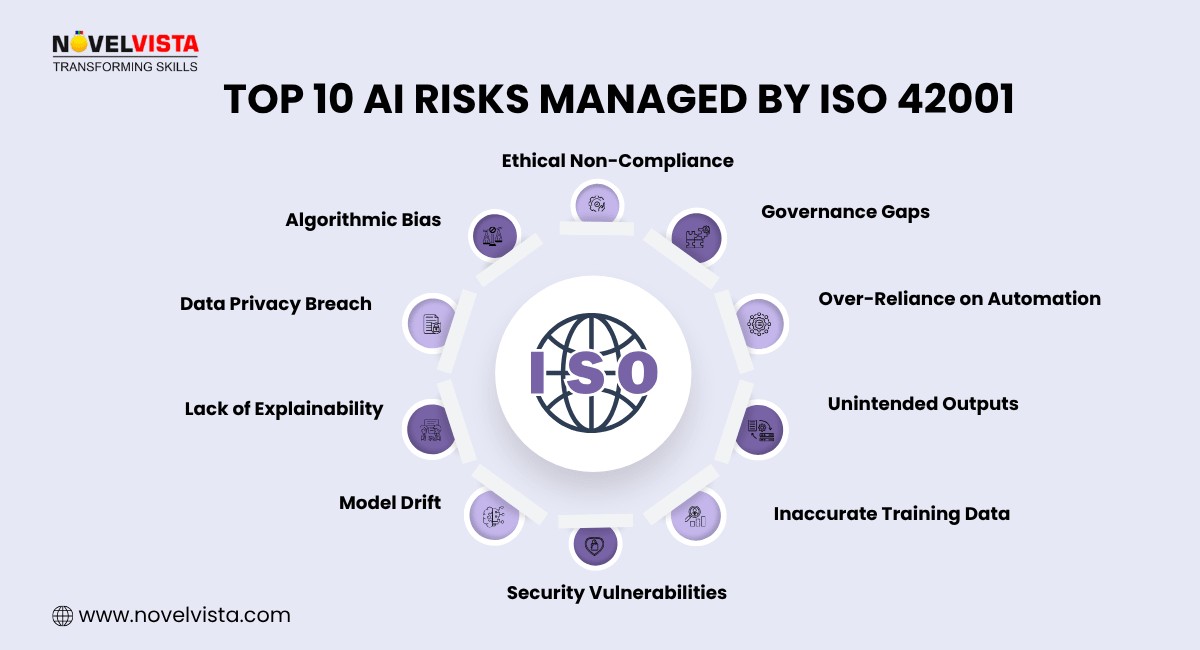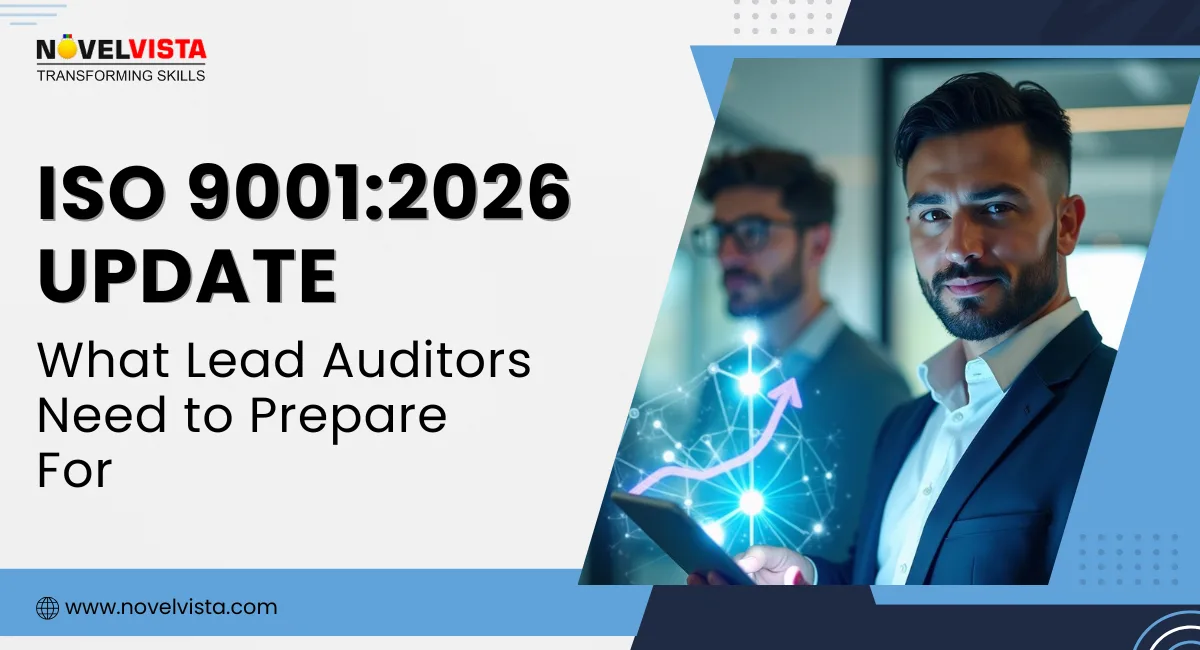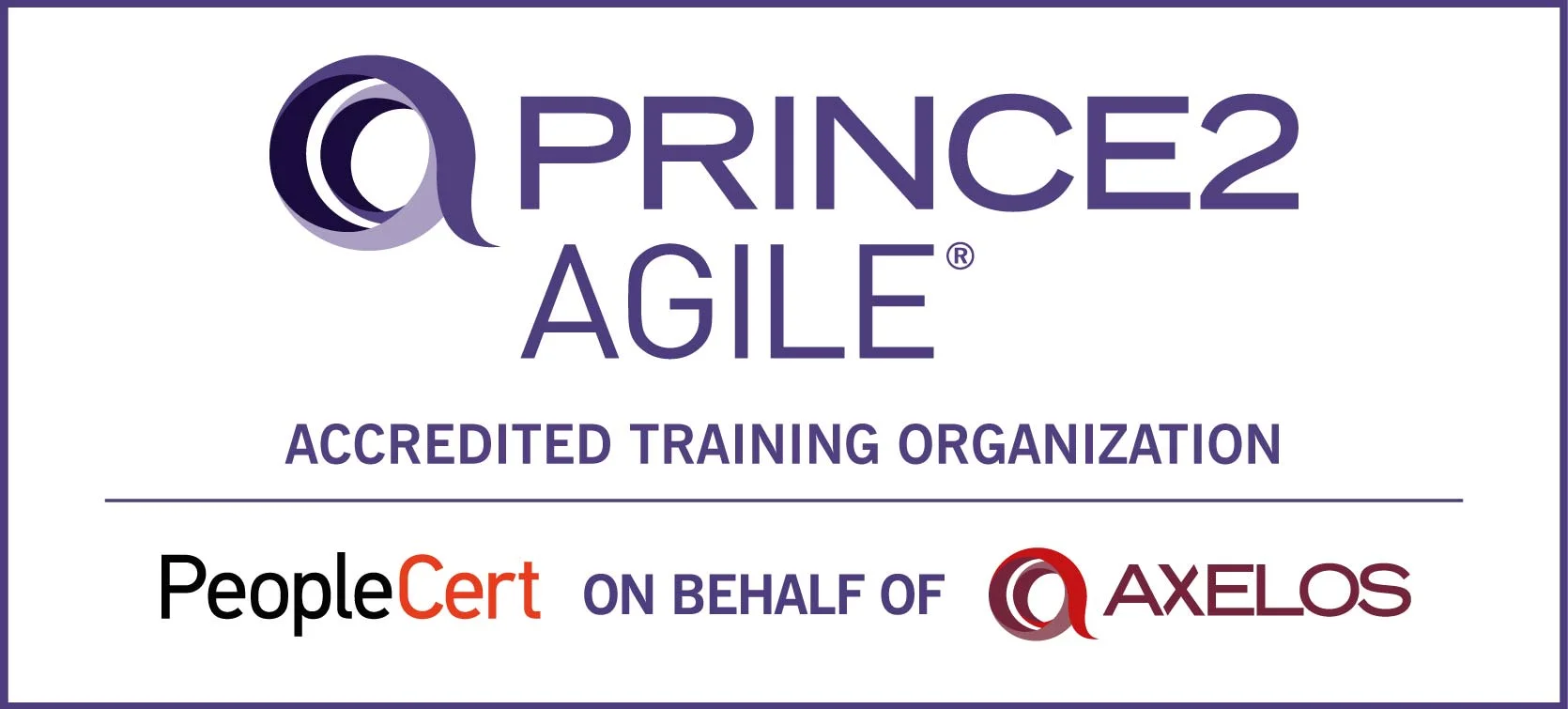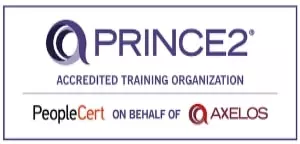- Understanding ISO/IEC 42001 and Its Importance
- Core AI and Ethical Foundations in the ISO 42001 Syllabus
- Deep Dive into ISO 42001 Requirements (Clauses 4–10)
- Mastering Annex A in the ISO 42001 Syllabus
- ISO 42001 Audit Methodology and Auditor Competence
- The Audit Process in the ISO 42001 Syllabus
- Reporting, Closure, and Follow-Up
- Hands-On Learning and Practical Activities
- Certification and Career Impact of ISO 42001
- Conclusion: Building a Career in Ethical AI with ISO 42001
Have you noticed how quickly Artificial Intelligence (AI) is taking over industries — from automating business decisions to creating entire marketing campaigns? While this growth is exciting, it also raises serious questions: How do we keep AI ethical, transparent, and accountable?
That’s where the ISO 42001 syllabus comes into play. It helps organizations and professionals understand how to build, manage, and audit an AI Management System (AIMS) that’s responsible and compliant.
In this blog, you’ll get a clear, easy-to-understand breakdown of what the ISO 42001 syllabus includes — from its key topics to what you’ll learn and how it helps shape your career in AI governance.
Understanding ISO/IEC 42001 and Its Importance
2.1 What Is ISO/IEC 42001?
ISO/IEC 42001 is the world’s first international standard for AI Management Systems (AIMS). It defines how organizations should create frameworks to ensure their AI systems are safe, explainable, and fair.
Simply put, ISO 42001 helps companies move from “AI experiments” to “AI you can trust.”
If you’d like to explore the clauses and structure of the standard in depth, check out our detailed guide on ISO 42001 and its requirements.
2.2 Why a Formal ISO 42001 Syllabus Matters
A structured syllabus is important because it ensures every professional — whether they’re an AI engineer or compliance manager — learns the same foundational knowledge. The ISO 42001 syllabus brings consistency, clarity, and a measurable approach to understanding AI governance, risks, and responsibilities.
2.3 Who Should Learn It
This syllabus isn’t just for auditors. It’s ideal for:
- AI Developers and Data Scientists who want to build ethical AI models
- Compliance Managers and Risk Officers handling AI risk
- IT Governance Leaders responsible for aligning AI with business goals
- Ethics Professionals ensuring fairness and accountability in AI
2.4 What This Guide Covers
You’ll learn about everything from AI fundamentals and ethical principles to audit practices and career benefits. By the end, you’ll clearly understand how mastering the ISO 42001 syllabus prepares you for responsible AI implementation and certification.
Core AI and Ethical Foundations in the ISO 42001 Syllabus
The first stage of the ISO 42001 syllabus builds your foundation — helping you understand not just how AI works, but how it should behave.
3.1 AI Concepts and Terminology
Before you can audit or manage AI, you need to speak its language. The syllabus covers key concepts like:
- Machine Learning (ML): Teaching systems to learn from data
- Deep Learning: Using neural networks to make complex decisions
- Natural Language Processing (NLP): Understanding human language
- Neural Networks: The backbone of decision-making in AI models
These are not just buzzwords — they’re the starting point for responsible AI management.
3.2 Ethical AI Principles
Ethics is the heart of ISO 42001. You’ll learn about:
- Bias Mitigation: Preventing discrimination in AI decisions
- Fairness: Ensuring AI outcomes are just and equitable
- Transparency: Making AI processes explainable
- Accountability: Defining who is responsible for AI actions
These principles guide how organizations should design, test, and deploy AI safely.
3.3 Legal and Regulatory Context
The syllabus also introduces you to global AI regulations — like the EU AI Act, GDPR, and data protection laws — that influence how AI systems should operate responsibly. You’ll see how ISO 42001 aligns with these frameworks to make AI governance globally consistent.
3.4 Management System Fundamentals
ISO 42001 follows the High-Level Structure (HLS) and PDCA (Plan-Do-Check-Act) model. This gives you a familiar and systematic way to plan, implement, review, and improve AI governance processes.

Deep Dive into ISO 42001 Requirements (Clauses 4–10)
Now that you’ve built your base, the syllabus takes you deeper into the actual ISO 42001 framework — the clauses that define how an AI Management System works.
4.1 Context and Leadership (Clauses 4 & 5)
You’ll learn how to:
- Define the scope of your AIMS
- Identify stakeholder needs and AI impacts
- Establish AI policies that reflect ethical commitments
- Ensure leadership involvement in AI accountability
Strong leadership is what turns AI governance from theory into culture.
4.2 Planning and Support (Clauses 6 & 7)
Here’s where planning meets execution:
-
Develop necessary processes
-
Set measurable AI objectives
-
Develop competency frameworks for your teams
- Promote awareness and training for responsible AI behavior
This ensures everyone involved understands their role in maintaining AI ethics.
4.3 Operation and Performance Evaluation (Clauses 8 & 9)
You’ll explore:
- How to design, test, and deploy AI responsibly
- Methods for monitoring performance and auditing outcomes
- Conducting management reviews to keep the AIMS relevant
4.4 Improvement (Clause 10)
Finally, you’ll see how to continually improve your AIMS by identifying gaps, handling nonconformities, and ensuring consistent ethical outcomes over time.
Mastering Annex A in the ISO 42001 Syllabus
Annex A is the practical side of the syllabus — it gives you 39 specific AI controls that tackle real-world risks like data bias, misuse, and quality issues.
5.1 Overview of the 39 AI Controls
These controls cover:
- Data Quality and Integrity
- Algorithmic Bias Mitigation
- AI Model Monitoring
- Access and Transparency Measures
5.2 Control Mapping and Implementation
You’ll learn how to align these controls with your identified risks and apply them effectively to your AI systems. This is where theory becomes real action.
5.3 Using Annex B Guidance
Annex B acts as your best friend during implementation — offering examples and guidance to apply Annex A controls more efficiently.
You can explore our dedicated breakdown of ISO 42001 Annex A for detailed insights and examples.

ISO 42001 Audit Methodology and Auditor Competence
This part of the ISO 42001 syllabus prepares you for the audit side — where you evaluate whether organizations are actually following their AIMS correctly.
6.1 Principles of Auditing
You’ll understand the ISO 19011 auditing guidelines, focusing on:
- Integrity and Objectivity
- Confidentiality
- Professional Judgment
6.2 Role of the ISO 42001 Lead Auditor
As a lead auditor, your job is to:
- Manage audit teams
- Ensure evidence-based conclusions
- Maintain independence and accuracy
6.3 Managing Audit Programs
You’ll also learn to plan, execute, and report on surveillance, recertification, and integrated audits that combine ISO 42001 with other management systems.
The Audit Process in the ISO 42001 Syllabus
Once you’ve understood the structure and clauses of ISO 42001, the syllabus moves into how audits actually happen. This is where everything you’ve learned — from documentation to risk assessment — gets tested in practice.
7.1 Audit Planning and Preparation
Every audit starts with a plan. The ISO 42001 syllabus teaches you how to:
- Define the audit scope (what’s included and what’s not)
- Select the right audit criteria based on clauses and controls
- Build the right audit team with clear responsibilities
Good planning saves hours of confusion later and ensures a smooth, objective audit process.
7.2 Stage 1 Audit: Readiness and Documentation Review
This stage is like a “pre-check.” You’ll review documentation, policies, and AIMS records to ensure the organization is ready for a full audit.
It helps catch issues early — before they become serious nonconformities.
7.3 On-Site Audit Execution
Once the documentation looks good, it’s time for the on-site audit. This part involves:
- Conducting interviews with key personnel
- Reviewing evidence of AI management practices
- Observing how AI systems operate in real conditions
The syllabus also stresses the importance of clear communication and accurate documentation — two skills every great auditor must have.
Download: ISO 42001 Lead Auditor Guide
Become a certified ISO 42001 Lead Auditor, Follow this
proven step-by-step roadmap to master AI
governance and fast-track your certification success.
Reporting, Closure, and Follow-Up
After the on-site audit, it’s time to turn observations into structured findings.
8.1 Reporting Findings
You’ll learn how to write an audit report that clearly identifies:
- Nonconformities — areas where the AIMS doesn’t meet ISO 42001 requirements
- Observations — potential improvement areas
- Recommendations — actionable steps to strengthen the system
The key is clarity — making sure management understands exactly what needs attention and why.
8.2 Closing the Audit
This is where auditors and management meet to review findings, discuss any disagreements, and agree on next steps. The ISO 42001 syllabus emphasizes collaboration — the goal is improvement, not blame.
8.3 Corrective Actions
Finally, you’ll learn how to evaluate corrective actions to ensure problems are fixed and don’t repeat. It’s the last, but one of the most valuable steps — because continuous improvement is what ISO 42001 is all about.
Hands-On Learning and Practical Activities
What makes the ISO 42001 syllabus stand out is how practical it is. It’s not just theory — it’s filled with real exercises that make learning stick.
9.1 Interactive Exercises
Every topic comes with group discussions, quizzes, and scenario-based tasks that help you connect ISO 42001 concepts with actual workplace situations.
9.2 Case Studies
You’ll go through real-world AI governance examples — like handling bias in a machine learning model or documenting an AI risk assessment. Seeing how these issues are resolved in practice builds real confidence.
9.3 Simulated Audits
To prepare for real audits, the syllabus includes mock audit sessions where learners play different roles — auditor, auditee, and observer. It’s a fun, engaging way to experience the full audit cycle without the pressure.
Certification and Career Impact of ISO 42001
Getting certified after completing the ISO 42001 syllabus isn’t just about a certificate — it’s about unlocking a new level of credibility in AI governance.
10.1 ISO 42001 Certification Exam Details
The certification exam usually covers:
- Multiple-choice questions
- Scenario-based questions on AI risk, ethics, and management
- Practical case analysis
It’s designed to test your understanding of both the standard and its real-world application.
10.2 Career Benefits
Once certified, your career opportunities expand significantly. Some popular roles include:
- AI Compliance Officer
- AI Governance Manager
- AI Risk Consultant
- ISO 42001 Lead Auditor
- AI Ethics and Assurance Lead
Professionals who complete the ISO 42001 syllabus and earn certification often see improved credibility, better salary potential, and more global career options — especially as AI governance becomes a mandatory part of business strategy.
10.3 Continuous Professional Development
The learning doesn’t stop after certification. The syllabus encourages ongoing development through refresher courses, AI ethics workshops, and new regulation updates — keeping you aligned with evolving AI standards.
Conclusion: Building a Career in Ethical AI with ISO 42001
The ISO 42001 syllabus gives professionals a roadmap to understand, manage, and audit AI responsibly. It combines ethical frameworks, system management, and real-world application — ensuring you’re ready to lead in the era of trustworthy AI.
By mastering it, you’re not just improving your skills — you’re contributing to a world where AI serves society safely and transparently.
Next Step: Begin Your ISO 42001 Journey with NovelVista
Ready to take the next step?
Enroll in NovelVista’s ISO 42001 Lead Auditor Certification Training — your gateway to mastering AI governance. Learn directly from industry experts, explore real-world case studies, and gain practical audit experience.
With ISO 42001 certification, you’ll be equipped to shape ethical AI systems, lead responsible innovation, and stand out as a trusted professional in a rapidly evolving AI landscape.
Start your journey today and become the voice of responsible AI governance.
Frequently Asked Questions
Author Details

Akshad Modi
AI Architect
An AI Architect plays a crucial role in designing scalable AI solutions, integrating machine learning and advanced technologies to solve business challenges and drive innovation in digital transformation strategies.
Course Related To This blog
ISO 42001 Lead Auditor
Confused About Certification?
Get Free Consultation Call









